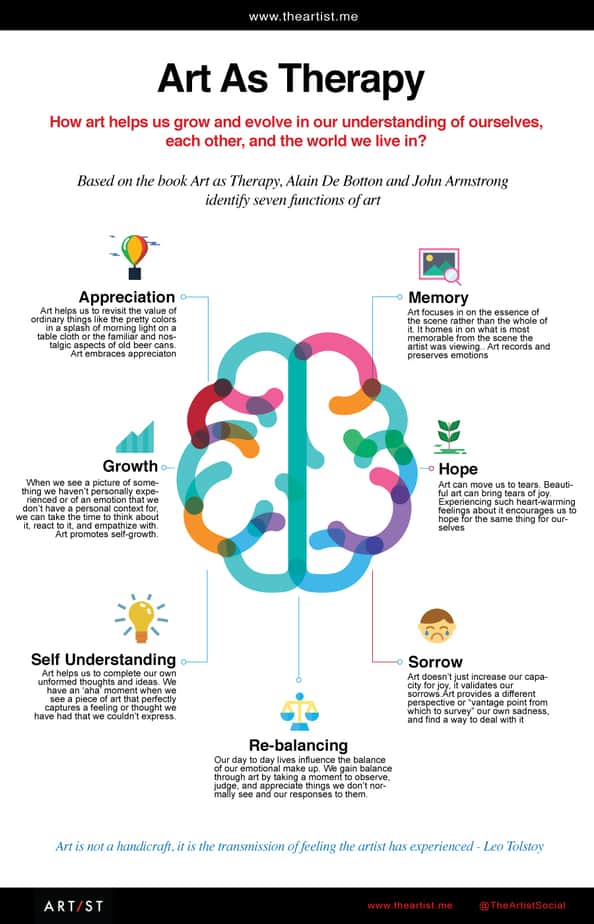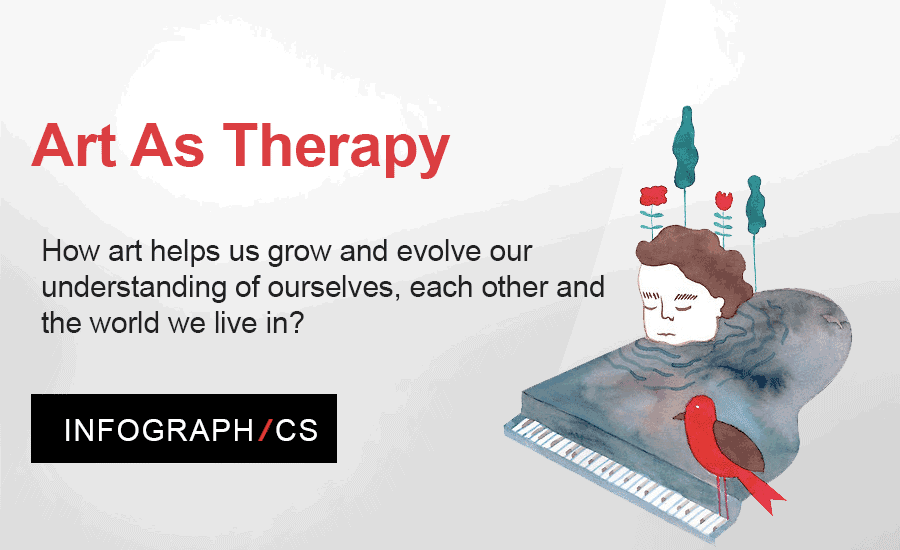Art is a form of creative human expression, a way of enriching the human experience. We use the art for our entertainment, cultural appreciation, aesthetics, personal improvement, and even social change – and most importantly use Art as Therapy.
Whether or not we are aware of it, we allow art to affect our lives one way or another.
In the famous book Art as Therapy by Alain De Botton, the author has outlined seven functions of art and explains how art helps us grow and evolve in our understanding of ourselves, each other, and the world we live in. Taking your time to mindfully observe artwork can be of true value to your emotional well-being.
In viewing art, our perceptions change and grow, leading to growth and change in ourselves.

How to use Art as Therapy?
Memories
We live in a world of stress and distraction so it is hard for us to remember everything. We often write down what we need to remember. To remember something sentimental or something that stirs great feelings in us, we make an image of it.
In our day and age, we snap a picture of what we want to remember, but before the snapshot came art.
Art focuses on the essence of the scene rather than the whole of it.
It homes in on what is most memorable from the scene the artist was viewing. DaVinci could have put detail into every part of Mona Lisa, but he chose to light up her smile.
Van Gogh made it quite obvious that the brilliance of the stars in the night sky were the things meant to make you reminisce.
Artists not only preserve a visual reminder of a memory, but they also record the emotions associated with the memory. When we view the image, whether it is one from our own memory or someone else’s, we tap into that remembered emotion and relate it to our own past experiences.
Hope
The authors argue that a person viewing a pretty picture is neither ignoring nor forgetting reality. They cannot see a picture as beautiful without the contrast of what they know to be true about the harshness and stress of life.
We give most of our focus to the things in our lives that cause us stress and negative emotions. The authors point out that we need pretty art to give us hope.
Art reminds us that there is beauty in the world that we can strive to see it, appreciate it, and have it.
Art can move us to tears.
Beautiful art can bring tears of joy when we see a painting, sculpture or photograph of people or creatures experiencing things we want to experience. Experiencing such heart-warming feelings about it encourages us to hope for the same thing for ourselves.
Sorrow
Art doesn’t just increase our capacity for joy, it validates our sorrows.
Because we can appreciate and identify with sorrow shown in a work of art, we are able to take solace in not being alone in those feelings and reactions. We are also able to turn the sympathy we have for the subject to ourselves. Art helps us see that sorrow can be beautiful and noble and still be one aspect of a good life.
The power of art lies neither in the image nor the emotions it arouses in the viewer, rather its greatness is derived from understanding the creative forces which inspired the masterpiece.
Goya’s black paintings series is a great example that proves this theory.
Art also helps us to suffer alone without the input of society so that we can show a dignified face to the world in our public sorrow. It provides a different perspective or “vantage point from which to survey” our own sadness and how we deal with it privately and how we show it to the outside world.
Rebalancing (The Most Powerful Way to Use Art as Therapy)
Our day to day lives influences the balance of our emotional makeup. A stockbroker might be balanced toward a fast panic, a social worker toward depression, or a pre-school teacher toward excitement and childlike happiness.
Viewing art that depicts situations and feelings outside of what we normally experience on a daily basis helps us attain balance in our emotions by filling those voids.
Our negative responses to art also help us to see what it is within ourselves that hate the image.
In doing so, art questions our moral reasoning, asking us to put aside our judgments and rethink the situation. Though it may seem bossy, art encourages us to better ourselves by examining unfamiliar or negative issues.
We gain balance through art by taking a moment to observe, judge, and appreciate things we don’t normally see and our responses to them.
Self-Understanding
Art helps us to complete our own unformed thoughts and ideas.
We have an ‘aha’ moment when we see a piece of art that perfectly captures a feeling or thought we have had that we couldn’t express. When this happens, we have gained a piece of new knowledge through the art that we can now communicate to ourselves and to others.
People express the self-understanding they have gained from art in the images they put on their walls, upload to social media, or wear on their t-shirts.
Growth
When we see a picture of something we haven’t personally experienced or of an emotion that we don’t have a personal context for, we can take the time to think about it, react to it, and empathize with it.
If we were to encounter that situation in reality without having ever seen it before in art we wouldn’t have the time to think about it before judging or reacting.
Because we have been exposed to these situations in art and have processed them in our minds when we encounter them in the world we have a prior context in which to organize our thoughts about them and react in a kinder way than we might have otherwise.
That is growth.
Appreciation
Humans are creatures of habit and routine. We often miss seeing the average, everyday things that surround us. When we do think outside of our routines, we often think about things we aspire to have and not the things that we do have.
Art helps us to revisit the value of ordinary things like the pretty colors in a splash of morning light on a table cloth or the familiar and nostalgic aspects of old beer cans.
Art also points out that things we don’t normally see as beautiful can be, and that we can be beautiful as well. As a society, we strive to achieve a certain body type, but Ruben shows us the beauty in another. Vermeer asks us to forget altogether the physical beauty of a woman is and to instead look at the beauty of her capacity for feeling.
When we appreciate the things that art points out to us we are kinder to ourselves and to others.
Recognizing and remembering these seven functions of art as therapeutic tools for personal growth the next time that you encounter art will hopefully enhance your experience of the image you are looking at.
Taking the time to mindfully observe artwork is shown by the authors of Art as Therapy to be of true value to your emotional well-being.


